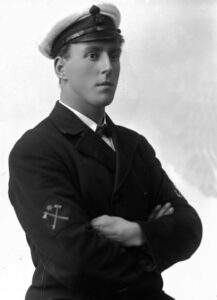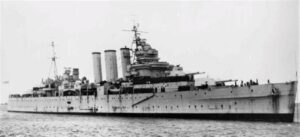The following biography is based on that prepared by the Museum of Perth for the Soldiers of Barrack Street exhibition. Included in the second part of this paper is a story of how Patrick Murphy’s portrait was discovered. This information is republished with thanks to John Murphy (grandson of Patrick Murphy) for his assistance.

Image courtesy of the State Library of Western Australia: 108045PD
The son of William and Norah Murphy, Patrick was born 25 February 1894 at Castletown, County Cork, Ireland. A career shipwright, he came to NSW after enlisting in the RAN in London , aged 21, on 11 December 1915.
He served throughout the war on land, in Australia and New Guinea, and at sea on Cerberus and Encounter. At this time Encounter was engaged in convoy protection duties in the Pacific and the protection of merchant shipping sailing around Cape Leeuwin in Western Australia. After the war he remained in the Navy and, in 1924, married Ada Clare Stephens (23) in Burwood, NSW. In later life they lived in Clovelly
In 1938, at the rank of Chief Shipwright First Class, Patrick transferred to Auxillary Services as a constable with the Sydney Dockyard Police (Garden Island). Later that year he was awarded a Medal of the Order of the British Empire for Meritorious Service (Military Division).
In 1939, with the advent of WWII, he was commissioned for active service (land based), but transferred back to sea-going service in March 1942. He was posted to HMAS Canberra (I) in April 1942 where he served until her loss in the Battle of Savo Island on 9 August 1942. After survivors leave he was posted to the London Depot on 16 October as a member of the commissioning crew for HMAS Shropshire. The British Government had approved the transfer of Shropshire to the Royal Australian Navy as a replacement for HMAS Canberra on 8 September 1942.
In May 1943 during his time in Canberra he had been commissioned as a temporary Acting Warrant Shipwright.

After the commissioning of Shropshire on 20 April 1943 under the command of Captain John A Collins CB RAN, maintenance and other preparations Shropshirebegan her voyage to Australia in August. She arrived at Cape Town on 4 September and Fremantle three weeks later.
During the ships visit to Cape Town on 5 September 1943, Patrick (49) was last seen on the dock at Table Bay. Two days later his body was recovered from the water nearby and he was buried at Dido Valley Cemetery, Simonstown, South Africa.
Ada outlived him by 30 years and died in NSW, aged 75.
Glass Plate Photography and the Soldiers of Barrack Street

Between 1851 and the late 1920s there were two basic types of glass plate negatives used in photography. These were ‘collodion’ or wet plate and ‘gelatin’ dry plate. Wet plate negatives were in use until the 1880s. Silver gelatin-coated dry plate negatives invented in 1871 became available in 1873 as a cost effective and durable photographic medium. They remained in common use until the late 1920s.
In 1915 Patrick Murphy’s photographic portrait was produced at the Desae Studio in Barrack Street, Perth using this process. He had likely taken advantage of an offer by the studio which, from the 15 August 1914 had advertised a discounted price for any soldier departing for the front. Then, from the 20th of June 1915 coupons were provided in The Sunday Times to have the portraits done for free.
The story of how the Murphy glass plate negative and those of 740 other WWI servicemen were discovered and handed over to the Museum of Perth is of interest. They are now exhibited in a collection known as ‘The Soldiers of Barrack Street’[i].
‘The Soldiers of Barrack Street’ focuses on the work of famed West Australian photographer Denis Dease[ii] who operated the Dease studio at 117 Barrack Street from 1898 to 1929. Dease was a prolific photographer of great significance. He was highly respected and creative but was also an Aussie larrikin.Through his practice, Dease chronicled the changing faces and fashions of Perth through arguably the most interesting period of our recent history; from Gold-Rush to the outbreak of the “Great War” and through to the Great Depression.
The ‘Soldiers of Barrack Street’ are all joined to one another through their service, as well as their portraits taken at the Dease Studio from 1914 to 1919.
533 boxes of half plate glass negatives (approximately 6,500 images) from the Dease studio were found in the basement of a Perth fire station in the 1980’s as it was being prepared for demolition. It is believed the negatives had been purchased with the intention of being used as break glass in fire alarms throughout the buildings of Perth. Thankfully the negatives were gifted to the WA Museum and later, the State Library of Western Australia, for preservation. Within this vast collection approximately 741 images of World War 1 Service Men were identified.[iii]
[i] Museum of Perth, Soldiers of Barrack Street exhibition, available at: https://www.museumofperth.com.au/the-soldiers-of-barrack-st
[ii] The Life of Denis Dease 1869-1959, available at: http://www.thesoldiersofbarrackstreet.com/the-photographer
[iii] The Soldiers of Barrack Street, Photographic Portraits by Denis Dease available at: http://www.thesoldiersofbarrackstreet.com/the-project




